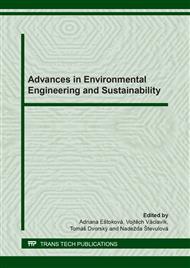[1]
P.O. Awoyera, A. Adesina, R. Gobinath, Role of recycling fine materials as filler for improving performance of concrete - a review. AJCE (2019).
DOI: 10.1080/14488353.2019.1626692
Google Scholar
[2]
V. Vaclavik, M. Kusnerova, T. Dvorsky, V. Simicek, J. Valicek, L. Gola, M. Harnicarova, Monitoring of the thermal properties of cement composites with an addition of steel slag. Advanced Structured Materials 72 (2018) 107-118.
DOI: 10.1007/978-3-319-59590-0_10
Google Scholar
[3]
N. Junakova, J. Junak, Sustainable use of reservoir sediment through partial application in building material, Sustainability 9 (2017).
DOI: 10.3390/su9050852
Google Scholar
[4]
M. Singh, B. Saini, H.D. Chalak, Performance and composition analysis if engineered cementitious composite (ECC) – a review, J. Build. Eng. 26 (2019).
DOI: 10.1016/j.jobe.2019.100851
Google Scholar
[5]
T. Dvorsky, V. Vaclavik, V. Simicek, A. Brenek, Research of the use of waste rigid polyurethane foam in the segment of lightweight concretes, Inz. Miner. 2 (2015) 51-56.
Google Scholar
[6]
J. Junak, A. Sicakova, Concrete containing recycled concrete aggregate with modified surface, Procedia Eng. 180 (2017) 1284-1291.
DOI: 10.1016/j.proeng.2017.04.290
Google Scholar
[7]
P.M. Zhan, Z.H. He, Application of shrinkage reducing admixture in concrete: A review, Constr. Build. Mater. 201 (2019) 676-690.
DOI: 10.1016/j.conbuildmat.2018.12.209
Google Scholar
[8]
B.C. Gayana, K.R. Chandar, Sustainable use of mine waste and tailings with suitable admixture as aggregates in concrete pavements – A review, Adv. Concr. Constr. 6 (2018) 221-243.
Google Scholar
[9]
A. Brenek, V. Vaclavik, T. Dvorsky, J. Daxner, V. Dirner, Built-in moisture process in structure with damaged waterproofing after the application of thermal insulation boards, Adv. Mater. Res. 1020 (2014) 591-596.
DOI: 10.4028/www.scientific.net/amr.1020.591
Google Scholar
[10]
H.S. Muller, M. Haist, M. Vogel, J.S. Moffat, Design approach and properties of new generation of sustainable structural concretes, ACI Special Publication, 326 (2018).
Google Scholar
[11]
M.A. Kamal, recycling of fly ash as an energy efficient building material: A sustainable approach, Key. Eng. Mater. 692 (2016) 54-65.
DOI: 10.4028/www.scientific.net/kem.692.54
Google Scholar
[12]
A. Brenek, V. Vaclavik, T. Dvorsky, J. Daxner, V. Dirner, M. Bendova, M. Harnicarova, J. Valicek, Capillary active insulations based on waste calcium silicates, Advanced Structured Materials 70 (2015) 177-188.
DOI: 10.1007/978-3-319-19443-1_14
Google Scholar
[13]
N. Stevulova, I. Schwarzova, V. Hospodarova, J. Junak, Implementation of waste cellulosic fibres into building materials, Cem. Eng. Trans. 50 (2016) 367-372.
Google Scholar
[14]
A. Struharova, S. Uncik, S. Balkovic, M. Hlavinkova, influence of fluidized fly ash on the selected physical-mechanical properties of the autoclaved aerated concrete, Adv. Mater. Res. 899 (2014) 409-414.
DOI: 10.4028/www.scientific.net/amr.899.409
Google Scholar
[15]
A. Sicakova, M. Spak, M. Kozlovska, M. Kovac, Long-term properties of cement-based composites incorporating natural zeolite as a feature of progressive building material, Adv. Mater. Sci. Eng. 2017 (2017).
Google Scholar
[16]
M. Spak, Mechanical properties of mortars prepared by alkali activated fly ash coming from different production batches, Solid State Phenom. 244 (2016) 140-145.
DOI: 10.4028/www.scientific.net/ssp.244.140
Google Scholar
[17]
V. Corinaldesi, S. Monosi, Characterization of colored self-compacting concretes, ACI Special Publication 288 (2012) 351-363.
Google Scholar
[18]
V. Corinaldesi, S. Monosi, L.M. Reullo, Influence of inorganic pigments addition on the performance of coloured SCC, Constr. Build. Mater. 30 (2012) 289-293.
DOI: 10.1016/j.conbuildmat.2011.12.037
Google Scholar
[19]
G.M. Revel, M. Martarelli, M.A. Bengochea, A. Gazalbo, M.J. Orts, A.Gaki, M. Gregou, M. Taxiarchou, A. Bianchi, M. Emiliani, Nanobased coatings with improved NIR reflecting properties for building envelope materials: Development and natural aging effect measurement, Cement Concrete Comp. 36 (2013) 128-135.
DOI: 10.1016/j.cemconcomp.2012.10.002
Google Scholar
[20]
A. Lopez, J.M. Tobes, G. Giaccio, R. Zerbino, Advantages of mortar-based design for coloured self-compacting concrete, Cement Concrete Comp. 36 (2013) 128-135.
DOI: 10.1016/j.cemconcomp.2009.07.005
Google Scholar
[21]
Information on https://www.asb.sk/stavebnictvo/zaklady-a-hruba-stavba/cement-beton/ specialne-betony.
Google Scholar
[22]
L. Hatami, M. Jamshidi, Influence of pigment content and cement type on appearance and performance of colored self-compacting mortars (C-SCMs), Int. J. Civ. Eng. 15 (2017) 727-736.
DOI: 10.1007/s40999-017-0170-2
Google Scholar
[23]
J. Kotatkova, P. Reiterman, Coloured concrete with focus on the properties of pigments, Adv. Mat. Res. 1054 (2014) 248-253.
DOI: 10.4028/www.scientific.net/amr.1054.248
Google Scholar
[24]
M. Resheidat, B. Al-Kharabsheh, SEM and XRD analyses and testing of milled natural oxides used for colored concrete, JJCE 10 (2016) 480-488.
Google Scholar
[25]
P. Weber, Pigments for coloring concrete powder –liquid color – granules – compact pigment: Who is the champion? Concrete Precasting Plant and technology 12 (2006) 14-21.
Google Scholar
[26]
A. Lopez, G.A. Guzman, A.R. Di Sarli, Color stability in mortars and concretes. Part 1: Study on architectural mortars, Constr. Build. Mater. 120 (2016) 317-622.
DOI: 10.1016/j.conbuildmat.2016.05.133
Google Scholar
[27]
A. Lopez, G.A. Guzman, A.R. Di Sarli, Color stability in mortars and concretes. Part 2: Study on architectural concretes, Constr. Build. Mater. 123 (2016) 248-253.
DOI: 10.1016/j.conbuildmat.2016.06.147
Google Scholar
[28]
Slovak Office of Standards, Metrology and Testing. STN EN 197-1: Cement. Part 1: Composition, specifications and conformity criteria for common cements, Slovak Office of Standards, Metrology and Testing: Bratislava, Slovakia, (2012).
Google Scholar
[29]
Slovak Office of Standards, Metrology and Testing. STN EN 206+A1: Concrete. Specification, performance, production and conformity, Slovak Office of Standards, Metrology and Testing: Bratislava, Slovakia, (2017).
Google Scholar
[30]
Slovak Office of Standards, Metrology and Testing. STN EN 12620+A1: Aggregates for concrete, Slovak Office of Standards, Metrology and Testing: Bratislava, Slovakia, (2008).
Google Scholar
[31]
Slovak Office of Standards, Metrology and Testing. STN 73 1316: Determination of moisture content, absorptivity and capillarity of concrete, Slovak Office of Standards, Metrology and Testing: Bratislava, Slovakia, (1989).
Google Scholar
[32]
Slovak Office of Standards, Metrology and Testing. STN EN 12390-3/AC: Testing hardened concrete. Part 3: Compressive strength of test specimens, Slovak Office of Standards, Metrology and Testing: Bratislava, Slovakia, (2012).
DOI: 10.3403/30360097
Google Scholar


